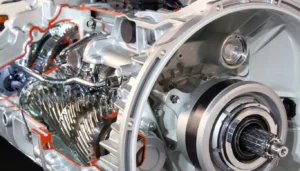Shifting gears on a motorcycle is necessary to maintain control of the bike and ensure that the engine is operating at the proper RPM for the speed of the motorcycle. Riding in the wrong gear can cause the engine to bog down or over-rev, leading to decreased performance, increased fuel consumption, and potential damage to the engine.
Shifting gears also allows the rider to adapt to changing road conditions and traffic situations. For example, shifting to a lower gear can provide more power for accelerating out of a turn or passing another vehicle, while shifting to a higher gear can improve fuel efficiency and reduce engine noise when cruising at a steady speed.
Shifting gears is an essential skill for any motorcycle rider, and it’s important to shift gears at the right time and use the clutch to ensure a smooth and safe ride.
What is Shifting on A Motorcycle?
Shifting on a motorcycle refers to the process of changing gears by adjusting the gear ratio between the engine and the rear wheel. This process is accomplished by using the clutch and gear shifter located on the motorcycle.
A typical motorcycle gearbox has multiple gears, usually between 4 to 6, which are selected by tapping the gear shifter with your left foot. When shifting gears, the engine RPM and speed of the motorcycle need to be matched to ensure a smooth transition.
To shift gears, you start by pulling in the clutch lever on the left handlebar, which disengages the engine from the gearbox. You then shift up or down by tapping the gear shifter up or down with your left foot, depending on your speed and riding conditions.
Once you have selected the appropriate gear, you gradually release the clutch lever while opening the throttle with your right hand to match the engine speed with the rear wheel. This engages the engine and allows power to be transferred to the rear wheel, propelling the motorcycle forward.
Shifting gears on a motorcycle is an essential skill for any rider, as it allows you to adjust your speed and maintain control of the motorcycle while navigating different road conditions. With practice, shifting gears becomes second nature, and you’ll be able to shift up and down seamlessly while maintaining control of the motorcycle.
When to Shift Gear on A Motorcycle
Knowing when to shift gear on a motorcycle is an important skill that requires understanding the relationship between the engine speed, motorcycle speed, and gear ratio. Shifting gears at the right time can help you maintain control, improve fuel efficiency, and reduce wear and tear on your motorcycle’s engine and transmission.
Here are some general guidelines for when to shift gears on a motorcycle:
Upshifting:
You should shift up to a higher gear when the engine is revving too high for the speed you’re traveling. This generally means upshifting when you’re approaching the upper end of the current gear’s RPM range.
For example, when cruising at around 40 km/h in second gear, you might upshift to third gear when the engine RPMs reach around 5000 RPM.
Downshifting:
You should downshift to a lower gear when you need more power or engine braking to slow down or accelerate.
This generally means downshifting when the engine is struggling to maintain power and you need more RPMs to match your speed. For example, when slowing down to make a turn, you might downshift from fourth gear to third gear to maintain a good balance between speed and power.
Avoid lugging the engine:
Lugging the engine means running it at a low RPM with a high gear, which can cause the engine to strain and wear out faster. To avoid lugging the engine, downshift to a lower gear when the engine RPMs fall below a certain range. As a general rule, you should try to keep the engine RPMs above 3000 when riding in city traffic and above 4000 RPM on the highway.
Remember that the specific timing of shifting gears will depend on a variety of factors, including your motorcycle’s make and model, your riding style, and the road and weather conditions. With practice, you’ll develop a feel for when to shift gears and be able to shift smoothly and efficiently without even thinking about it.
How To Shift A Motorcycle
Shifting gears on a motorcycle involves changing the ratio between the engine and the rear wheel, allowing you to accelerate, decelerate, and maintain your speed.
Get familiar with the motorcycle’s gearbox: The gearbox is usually located on the left side of the bike, and it is operated by a gear shifter that is located on the left footrest.
Always remember to shift gears smoothly and not to force the shifter or release the clutch too quickly to avoid damage to the transmission or stalling the engine.
Here are the steps to follow:
1. Get familiar with the motorcycle’s gearbox
The gearbox on a motorcycle is a mechanical device that transfers power from the engine to the rear wheel through a series of gears. The gearbox is typically located on the left side of the motorcycle and is operated by a gear shifter that is located on the left footrest.
Most motorcycles have a sequential gearbox, which means that you need to shift gears in a specific order. Typically, the gears are arranged in a “1 down, 5 up” configuration, meaning that first gear is located below neutral, and the remaining gears are located above neutral.
To shift gears, you’ll need to use the gear shifter located on the left footrest. To shift up, tap the gear shifter up with your left foot and to shift down, tap the gear shifter down with your left foot.
It’s important to note that different motorcycles may have slightly different gear patterns or may require different shifting techniques. Make sure to refer to the owner’s manual for your specific motorcycle to ensure proper gear shifting technique.
2. Start the engine
Starting the engine on a motorcycle can vary depending on the type of motorcycle you have. Here are the general steps for starting a motorcycle:
Make sure the motorcycle is in neutral: Ensure the motorcycle is in neutral by pulling in the clutch lever with your left hand and tapping the gear shifter down repeatedly until you see the N (neutral) indicator light up on the instrument cluster.
Turn on the ignition: Insert the key into the ignition switch, turn it to the “ON” position and wait for the instrument panel to light up.
Engage the clutch: With your left hand, pull in the clutch lever towards the handlebar.
Press the start button: On most motorcycles, the start button is located on the right handlebar switch cluster. Press and hold the start button until the engine fires up.
Release the clutch: Once the engine has started, slowly release the clutch lever while gradually opening the throttle with your right hand to match the engine speed with the rear wheel.
Let the engine warm up: Allow the engine to warm up for a few minutes before riding to ensure that the oil has warmed up and lubricated all the necessary parts.
Note: Always make sure to follow the manufacturer’s instructions and recommendations for starting and warming up your specific motorcycle model.
3. Clutch in
The clutch lever on a motorcycle is typically located on the left handlebar and is used to engage and disengage the engine from the gearbox.
To engage the clutch, pull the clutch lever towards the handlebar with your left hand. This disengages the engine from the gearbox, allowing you to change gears without damaging the transmission.
You’ll need to pull the clutch lever in every time you shift gears or come to a stop. This ensures that the engine is disengaged from the gearbox and prevents the bike from stalling.
Once you’ve selected the desired gear, slowly release the clutch lever while gradually opening the throttle with your right hand to match the engine speed with the rear wheel. This allows power to be transferred from the engine to the rear wheel, propelling the motorcycle forward.
Remember to always pull the clutch lever in when shifting gears or coming to a stop to ensure smooth gear changes and prevent stalling.
4. Shift up or down
Shifting gears on a motorcycle involves changing the ratio between the engine and the rear wheel, allowing you to accelerate, decelerate, and maintain your speed.
To shift up, you’ll need to increase your speed and engine RPM. While keeping the throttle open with your right hand, use your left foot to tap the gear shifter up, moving to the next higher gear. Release the clutch lever smoothly and gradually to engage the engine and rear wheel.
To shift down, you’ll need to slow down and decrease your engine RPM. While pulling in the clutch lever with your left hand, use your left foot to tap the gear shifter down, moving to the next lower gear. Release the clutch lever smoothly and gradually while gradually closing the throttle to engage the engine and rear wheel.
Remember to always use smooth and deliberate movements when shifting gears to prevent any sudden jerks or lurches that could cause instability or loss of control.
Note: When shifting gears on a motorcycle, it’s important to keep your focus on the road ahead and your hands and feet positioned correctly on the handlebars and footrests. This ensures that you can maintain balance and control of the motorcycle at all times.
5. Release the clutch
Releasing the clutch on a motorcycle is an important step in shifting gears and accelerating smoothly.
Once you’ve shifted to the desired gear and matched the engine speed with the rear wheel by opening the throttle, you’ll need to release the clutch smoothly and gradually to engage the engine and rear wheel.
To release the clutch, slowly let go of the clutch lever with your left hand while continuing to hold the throttle steady with your right hand. As you release the clutch, the engine will engage with the rear wheel, and the motorcycle will begin to move forward.
It’s important to release the clutch smoothly and gradually to prevent any sudden jerks or lurches that could cause instability or loss of control. This can take some practice to master, especially for new riders.
Remember to always release the clutch gradually and match the engine speed with the rear wheel to ensure a smooth and controlled acceleration.
6. Repeat
Shifting gears on a motorcycle is a repetitive process that involves changing the gear ratio between the engine and the rear wheel to match your speed and riding conditions.
Here are the general steps to repeat when shifting gears:
Pull in the clutch lever: To shift gears, always start by pulling in the clutch lever towards the handlebar with your left hand. This disengages the engine from the gearbox, allowing you to change gears without damaging the transmission.
Shift up or down: While keeping the throttle open with your right hand, use your left foot to tap the gear shifter up or down to select the next appropriate gear for your speed and riding conditions.
Release the clutch lever: Once you’ve selected the desired gear, slowly release the clutch lever while gradually opening the throttle with your right hand to match the engine speed with the rear wheel. This transfers engine power to the back wheel, propelling the motorcycle.
Repeat: As you continue to ride, you’ll need to shift gears up or down as needed to maintain your speed and adjust to changing road conditions.
Remember to always use smooth and deliberate movements when shifting gears to prevent any sudden jerks or lurches that could cause instability or loss of control. With practice, shifting gears will become second nature, and you’ll be able to shift up and down seamlessly while maintaining control of the motorcycle.
What is A Motorcycle Gear Shift Pattern?
A motorcycle gear shift pattern is a standard arrangement of gears that enables riders to easily shift between gears using the gear shift lever. Most motorcycles have a sequential gear shift pattern, meaning the gears must be did switch in order.
Motorcycles typically use the one-down, five-up gear shift pattern, which engages first gear by pressing down on the gear change lever with your left foot and the next five speeds by raising it up. Gears usually follow this order:
First gear: Press down on the gear shift lever to engage first gear.
Second gear: Lift the gear shift lever up from first gear to engage second gear.
Third gear: Lift the gear shift lever up from second gear to engage third gear.
Fourth gear: Lift the gear shift lever up from third gear to engage fourth gear.
Fifth gear: Lift the gear shift lever up from fourth gear to engage fifth gear.
Sixth gear: Some motorcycles have a sixth gear, which is engaged by lifting the gear shift lever up from fifth gear again.
It’s important to note that some motorcycles may have different gear shift patterns, depending on the make and model. For example, some older motorcycles may have a one-up, three-down pattern, which means that first gear is engaged by lifting the gear shift lever up, and the next three gears are engaged by pressing the gear shift lever down.
Regardless of the gear shift pattern on your motorcycle, it’s important to become familiar with the gear positions and practice shifting gears until it becomes second nature.
With practice, you’ll be able to shift smoothly and efficiently, allowing you to enjoy your ride while maintaining control of your motorcycle.
Motorcycle gear shifting tips
Here are some motorcycle gear shifting tips to help you shift smoothly and efficiently:
Use the clutch: The clutch is an essential part of shifting gears on a motorcycle. Always use the clutch to disengage the engine from the transmission before shifting gears. This will help you avoid jerky shifts and reduce wear and tear on the transmission.
Rev-match: Rev-matching is a technique used to match the engine speed with the speed of the rear wheel when downshifting. To rev-match, blip the throttle while pulling in the clutch lever before downshifting. This will help you shift more smoothly and reduce the risk of locking up the rear wheel.
Shift at the right time: Shifting at the right time is crucial for smooth gear changes. Shift up to a higher gear when the engine is revving too high for the speed you’re traveling, and downshift to a lower gear when you need more power or engine braking.
Don’t shift too early or too late: Shifting too early or too late can cause the engine to bog down or over-rev, respectively. Try to shift gears at the right RPM range for your motorcycle’s make and model.
Practice: The more you practice shifting gears on your motorcycle, the more natural it will become. Find an empty parking lot or quiet street and practice shifting up and down through the gears until you feel comfortable and confident.
Remember that shifting gears on a motorcycle is a skill that takes time and practice to master. With patience and persistence, you’ll be able to shift smoothly and efficiently, allowing you to enjoy your ride while maintaining control of your motorcycle.
Conclusion
Shifting gears on a motorcycle is an essential skill for any rider. By familiarizing yourself with the motorcycle’s gearbox, starting the engine, pulling in the clutch, shifting up or down, and releasing the clutch, you can shift gears smoothly and efficiently, helping you maintain control of your motorcycle and enjoy your ride.
It’s important to shift at the right time, use the clutch, and practice shifting gears regularly to become a skilled and confident rider. With these tips in mind, you can improve your motorcycle gear shifting technique and enjoy a safe and enjoyable ride.






